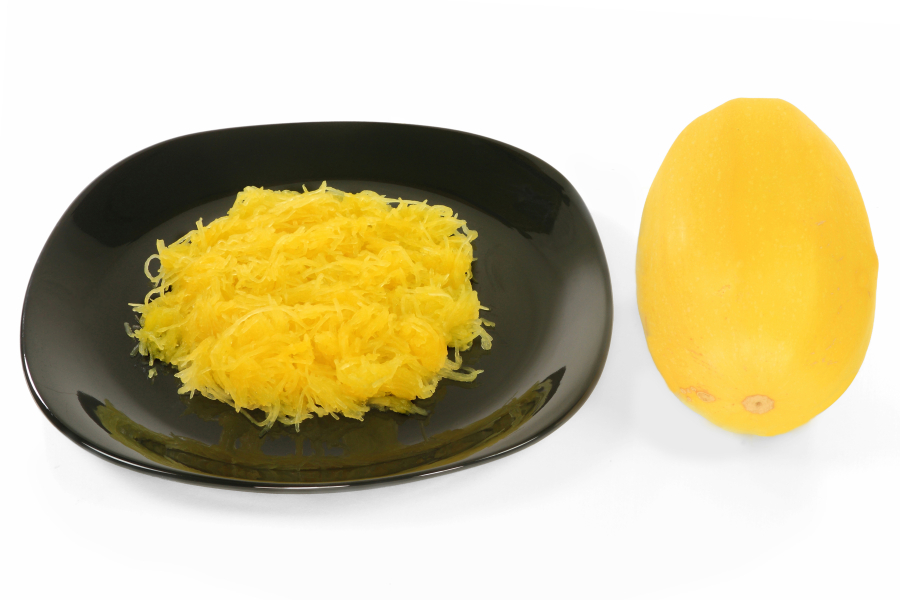Spaghetti squash delivers a nutritious treat as both a vegetable and a pasta. When cooked, its interior flesh peels apart like angel hair pasta. Also called noodle squash or vegetable spaghetti, it was one of the first commercially popular squashes in the U.S.
Unlike most winter squashes with roots in the Americas, spaghetti squash originates from China. Introduced into Japan in the 1920s by a Chinese agricultural research facility, the Burpee Seed Co. introduced it to the United States in 1936. During World War II, its popularity soared for inclusion in Victory Gardens; packaged pasta was scarce. After World War II, spaghetti squash’s popularity declined until the 1980s, when once again it reappeared as a favorite with vegetarians and dieters.
Today, spaghetti squash’s popularity continues to rise as people are intrigued by its unique pasta attributes and numerous health benefits.
Its low calorie (42 calories per cup) and high fiber content make spaghetti squash a favorite as a healthy gluten-free substitute for pasta. Additionally, it supplies an abundance of vitamins and contains every essential dietary mineral plus omega-3 and omega-6 fats.
Spaghetti squash is an 8- to 14-inch-long, watermelon-shaped vegetable weighing 2 to 3 pounds with a diameter of 5 to 8 inches. Depending upon variety, this squash can be pale to vibrant yellow. Presence of any green on the squash indicates under-ripeness or immaturity.
When selecting your spaghetti squash, choose those that are of uniform color and have a hard skin free of bruising, cuts, or soft spots. The squash should feel dense and heavy for its size. Preferably, there should be 1 to 2 inches of brown, dried stem still attached.
If you don’t plan to use it immediately, whole spaghetti squash can be stored at room temperature out of direct sunlight for several weeks or at storage temperatures of 50 to 60 degrees for up to six months. Never store whole squash in the refrigerator. Once you cut the squash, wrap and store it in the refrigerator to be used within two days.
When ready to eat, wash the squash under cool running water while rubbing the entire surface (especially around the stem end) to remove any dirt or debris.
To minimize cooking time, cut the squash in half and scoop out the pulp and seeds. Remember to save the seeds — they can be flavored and roasted for a nutritious, delicious snack or topping for salads or other dishes.
If you choose to cook the squash whole, remember to poke holes through the skin to allow steam to escape. This will prevent the squash from blowing up in your oven during cooking.
This squash can be baked, roasted, steamed, boiled or microwaved. My preference is to slice the squash along its long axis, remove the seeds and pulp and place the halves (cut side down) in a baking dish containing 1/2 inch of water. Cover the squash with foil and place in a pre-heated 350-degree oven. Cook until a fork easily pierces the skin and flesh. For whatever cooking method you choose, take extreme care when removing the flesh from the still-hot squash. Use a dinner fork to gently scrape the surface of the squash interior, pulling away from the long side to make the desired “spaghetti noodles.” If you have cooked the squash whole, cut and remove the seeds and pulp before pulling the “spaghetti noodles.”
These versatile “noodles” can be served by themselves, with a sauce, or included in a casserole, gratin, stew, or bake. Substitute for pasta in your favorite recipes.
For future enjoyment, spaghetti squash can be cooked and frozen or dehydrated. Unlike other winter squashes, spaghetti squash cannot be safely pressure canned.
For delicious spaghetti squash recipes and serving suggestions, check out Chef Scotty’s Market Fresh Recipes at http://ext100.wsu.edu/clark/?p=8163.
The WSU Extension website provides free, downloadable information and resources outlining safe and proven methods for dehydrating (PNW 397) and freezing vegetables (PNW 214) in addition to other preservation and food safety topics that may be of interest.
Leigh Rosenberger is a Clark County WSU Extension Master Food Preserver. For additional recipes, food preservation, and food safety tips, visit http://ext100.wsu.edu/clark/?p=1134. Questions? Call MFP 360-397-6060 ext. 5366, or join Facebook Discussion Group “WSU Home Food Preservers – Clark County.”



